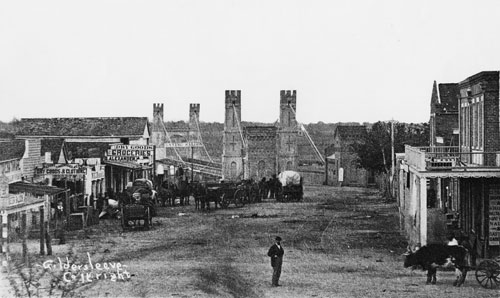Texas has changed quite a bit over the years, as is readily seen in our vast photograph collection. To help bring some of those changes to life, we’ve created a “Texas over Time” series of GIFs that will illustrate the construction and renovations of buildings, changing aerial views, and more. Our collections are especially strong on Waco and Baylor images, but look for some views beyond the Heart of Texas, too.

Photo dates: 1872, 1953, 1967, undated (prior to 1968)
- Named due to being across First Street from the Waco suspension bridge
- Earned the nickname “Rat Row” (until the fire) due to the increasingly dilapidated state of the wooden buildings
- Fire swept through in 1871, destroying all of the wooden frame buildings, which were replaced by stone ones
- Traditionally the center of the west-Waco minority-owned business community
- Took a major hit from the 1953 Waco tornado
- All buildings on street demolished in 1968 as part of Urban Renewal
Sources:
Menchu, Carlos. 162 Years of Waco, 1824-1986: Focus upon Downtown Waco, Texas. Lubbock: Texas Tech U, 1986. Print.
Smith, JB. “From Bridge Street to the Square.” Waco Tribune-Herald 22 Sept. 2005: n. pag. Print.
“Bridge Street: 1849 – 1890.” Baylor University Institute for Oral History. Web. 24 July 2014. <http://www.baylor.edu/oralhistory/index.php?id=32190>.
“Bridge Street: 1900-1950.” Baylor University Institute for Oral History. Web. 24 July 2014. <http://www.baylor.edu/oralhistory/index.php?id=32207>.
See the individual photos in our Bridge Street Flickr set.
GIF and factoids by Braxton Ray, archives student assistant









